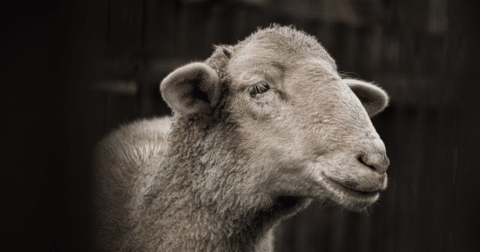Solutions
Chipotle’s Founder Is Betting on Plant-Forward Food
Food•2 min read
Reported
Hundreds of thousands of cattle and sheep could be at risk from ongoing hostilities in the Red Sea region.


Words by Sophie Kevany
Hostilities in the stretch of water between the Middle East and Africa known as the Red Sea have disrupted cargo and other ships, forcing massive vessels to take alternative routes to avoid Houthi militia attacks that began in mid-November last year. Rerouting goods is costly and inconvenient. But for animals crowded on to transport ships — unable to move freely and at risk of injury or water and feed shortages — the situation can quickly become dire.
At least one ship, which left Australia on January 5 bound for the Middle East with about 16,000 sheep and cattle on board, has already been ordered home by the Australian government. But in spite of hopes that the animals might be unloaded after their aborted journey, only a few hundred cattle have been taken from the boat so far. The rest remain on board the MV Bahijah, currently idling in or near the Western Australian port city of Fremantle.
Debates over whether the animals could be re-exported via a safer, longer route around Africa’s Cape of Good Hope ended Monday after the Australian government refused permission. The journey would have taken another month or so, said Jed Goodfellow, Director of Policy and Government Relations for the advocacy group, the Australian Alliance for Animals.
Still, the government did not say what should happen to the animals still on board, only that it would await decisions from the exporting company. A statement from the RSPCA urged the exporter it names as Bassem Dabbah, listed as an Israeli animal slaughtering company, “to avoid further unnecessary delay, and safely offload the animals as soon as possible and make immediate arrangements with local stakeholders.”
Each year, about two billion live animals are transported across water by the live export industry. While the Australian government did not answer questions about how many animals travel through the Red Sea from Australia every year, Goodfellow puts the 2023 total at about 250,000. Hostilities in the Red Sea area are not expected to end any time soon, which suggests hundreds of thousands of farm animals transported this way will be put at risk.
After a month at sea, Goodfellow says conditions for the animals on board the MV Bahijah would by now be “very poor,” with animals standing or lying in their own waste “in close quarters and in high heat and humidity.” Ammonia levels, he says, “will be high, irritating the animals’ eyes and airways. The animals will be stressed, creating the perfect environment for disease to spread. This will only get worse the longer the journey goes on.”
Official updates from Australia’s department of Agriculture, Fisheries and Forestry say the animals on board are in good health, and the ship has been cleaned and supplied with fresh feed and water. But animal welfare activists disagree with this assessment, arguing for the stressed, uncomfortable animals to be unloaded at once.
The Australian government appears to have now approved a second livestock shipment, offering no explanation for why this vessel would be allowed to pass through the Red Sea when the previous shipment had to return. A ship tracking website called Marine Traffic shows this second ship, MV Jawan, is currently on its way to Jordan, a route that will take it through the same Red Sea waters deemed too dangerous for the MV Bahijah.
The MV Jawan is reported to be owned by a Hamburg-based company, Jawan Compania Naviera SA, although another company, Mira International Shipping also claims ownership. It is not yet clear who currently owns the animals on board the ship. In the murky world of livestock shipping, confusion over who owns ships or the animals on board is common.
The Australian government has not replied to multiple emails asking for more details about the MV Jawan, the route it will travel and the animals on board. Nor did it confirm or deny whether there are animals on board but reports suggest the ship is loaded and, Lisa Chalk, with Animals Australia, said they understood the ship had a contingency plan in case of trouble. “[W]e believe the contingency plan if they run into trouble is to offload in the Gulf then truck them the rest of the way, [which is] not ideal. But the Jawan has made the trek successfully recently, which was likely a key consideration for the [government].”
“It appears [the Australian government] approved another livestock vessel, the MV Jawan, to depart Australia for Israel [or] Jordan and Marine Tracker data suggests it is going through the Red Sea. If this is confirmed, it will be an astonishingly brazen decision given the circumstances,” says Goodfellow.
The best option for the sheep and cattle stuck on board the first ship, MV Bahijah, would be to immediately unload them and slaughter them locally in Australia, says Goodfellow. “Industry spokespeople have confirmed the sheep could be sent straight to the abattoir, while the cattle would need to go to a feedlot for approximately 100 days for further fattening to meet the processor specifications,” he says.
The Alliance also estimates there are about 15,000 animals on board the MV Bahijah. Other reports have said there are 14,000 sheep and 2,000 cattle.
In a press release, the Alliance says the government had “already made a serious error of judgment” by allowing the MV Bahijah to set sail “knowing of the risks posed by Houthi Rebel attacks in the Red Sea as far back as November.”
Though Australia’s Chief Veterinary Officer has said that “there were no significant animal health or welfare issues identified,” two animal welfare researchers who study live transport of animals, Eugenie Duvall and Ben Lecorps, have disagreed with the government official’s finding. “It is difficult to imagine that animals being transported at sea for a month would not be affected,” they wrote in an email to Sentient.
The evidence is clear, according to Duvall and Lecorps, who wrote that the research demonstrates that “animals transported during long journeys are at greater risks for compromised welfare or worse.” Transport over water only exacerbates “these challenges,” they also said, pointing out that there are countries that have now banned, or say they will ban, live export on animal welfare grounds, including the New Zealand government (which has announced a ban), and Great Britain (which has introduced a ban in Parliament.
Duvall and Lecorp had not heard news of the second shipment, but they also offered this pointed critique: “if the authorities approved this shipment while knowing there were some potential security risks en route, they deliberately took the risk to put the entire animals on board in danger.”
Two years ago, almost 3,000 Spanish cattle spent over three months stuck at sea on board the livestock ships, Elbeik and Karim Allah. Several animals died on board, and some of the corpses were chopped up and thrown overboard.
Multiple attempts to offload the animals failed, including a planned sale of the livestock that fell through after a dispute over disease paperwork and a search for buyers at various ports in the Mediterranean. When those too failed, the ships eventually obeyed a Spanish government order to return. Finally, a mobile cull unit was brought to the docks in the Spanish port of Cartagena and all the surviving animals were killed.
By then, the animals were deemed not fit for further transport outside the European Union, and could not be accepted back into the EU due to disease control rules. The ruling essentially meant the animals had a one-way ticket and no Plan B once the initial shipment went awry, ultimately ending with a kill order.
In Australia, the animals may be quarantined to avoid concerns of disease spread if they were unloaded, but it is not clear how long that would last. During a press conference last Friday, Australia’s agriculture secretary, Adam Fennessy told journalists that the government was working to find a solution for the animals still on board the MV Bahijah. The animals, he said, now had fresh bedding and the ship was taking on extra feed and fuel. A vet working for the exporter remains on board and is providing daily animal health reports. Fennessy said the situation was “complex” and “unique,” and the government was doing “everything we can” to find a solution. A spokesperson for the Royal Society for the Protection of Animals expressed relief at the decision to deny a re-export plan, adding in part: “The only right decision now is to have these animals humanely processed in Australia. We would be extremely alarmed if there was any proposal to re-export them at a future time. They’ve suffered enough.”